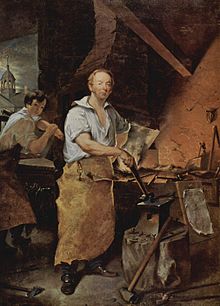John Neagle
John Neagle (born November 4, 1796 in Boston , † September 17, 1865 in Philadelphia ) was an American portrait painter of the early 19th century. During his life he was Philadelphia's most famous portrait painter after his teacher Thomas Sully , both of whom continued the British-influenced style of Sir Thomas Lawrence .
biography
John Neagle was born in Boston to the Irish immigrant Maurive Neagle and his wife Susannah, nee Tayler. His father died in 1800 and John Neagle grew up with his stepfather Lawrence Ennis in Philadelphia, where he received his earliest training in painting from his friend Edward F. Peticolas and later from the draftsman Pietro Ancora . He worked in his stepfather's shop until he was around 15 years old. Around 1813 Neagle met the sign and coat of arms illustrator Thomas Wilson, who introduced him to the painter Bass Otis . Neagle worked with Otis and learned portrait painting from him, beginning around 1815 with small oil studies that he could sell for about $ 5 apiece. Otis introduced him to Thomas Sully , who was the most famous painter in Philadelphia at the time.
In 1818, Neagle settled in Philadelphia as a portrait painter. He later made short visits to Lexington , where he met the work of Matthew Harris Jouett and was frustrated by the high quality, and to New Orleans . From 1821 Neagle exhibited his paintings regularly at the Pennsylvania Academy of the Fine Arts . From around 1824 Sully became his teacher and in July 1825 he traveled to Boston together with the engraver James Barton Longacre and visited the then very famous portrait painter Gilbert Stuart , who criticized Neagle's portrait style and had a lasting impact on it with his own style. In the fall of that year, Neagle was commissioned to paint one of his most famous paintings, Pat Lyon at the Forge. This painting was exceptional for its time, as the person depicted was shown at work in a forge .
In 1826 Neagle was commissioned to paint a series of actor portraits. The characters were to be painted in costumes and then used as templates for engravings to be used on the front of several stories entitled Acting American Theater . After Neagle had painted the first eight portraits to the satisfaction of the client, he was to paint more pictures in New York City. On May 28, 1826, Neagle married Mary Chester Sully, the niece and stepdaughter of his mentor Thomas Sully . During the ensuing honeymoon in New York, Neagle painted 24 portraits in New York, 16 of which were engraved. In 1827 he exhibited the completed work Pat Lyon at the Forge for the first time in the National Academy of Design , whereupon he was elected an Associate Member ( ANA ). In 1829 he also painted another version of this picture, which is still considered to be his most famous painting today; the year before, he had also been elected Honorary NA of the Academy.
In the years that followed, John Neagle and Thomas Sully dominated the Philadelphia portrait market as best-known portrait painters and agreed their prices with one another. Neagle painted local doctors, lawyers, politicians and merchants, and in 1833 he finished with the portrait of Dr. William Potts Dewees as its technically most praised painting. In 1834 he successfully applied as a drawing teacher at the Military Academy at West Point . From 1835 to 1843 Neagle was the first president of the Artists' Fund Society of Philadelphia , of which he was a founding member. From 1830 to 1831 he was also director of the Pennsylvania Academy of the Fine Arts .
In 1842 he was commissioned by a group of prominent Philadelphian citizens to portray the presidential candidate Henry Clay . The painting became the political symbol of the politician and the Germantown Clay Club around 1844. Neagle visited Clay in Lexington in 1843 and painted other portraits of prominent guests there.
Clay's portrait was Neagle's last major painting, and in 1845 he retired from public life after the death of his wife. He painted more portraits until 1850, but his style became more erratic and the pictures were accordingly less spectacular. Around 1853 Neagle suffered paralysis, which influenced his painting. He died in 1865, and a large part of his written estate is now administered by the American Philosophical Society .
Image selection
The Studious Artist , portrait by Thomas Birch
Individual evidence
- ^ Nationalacademy.org: Past Academicians "N" / Neagle, John ANA 1827; Honorary 1828 ( Memento of the original from January 16, 2014 in the Internet Archive ) Info: The archive link was inserted automatically and has not yet been checked. Please check the original and archive link according to the instructions and then remove this notice. (accessed on July 5, 2015)
literature
- Monroe H. Fabian: Neagle, John , Grove Art Online , Oxford University Press 2007; Access required.
- Robert Wilson Torchia: John Neagle , American National Biography Online 2000; Access required.
Web links
- Works by John Neagle at Zeno.org .
- The Neagle Papers , a collection of the writings and letters of the American Philosophical Society
- John Neagle at Artcyclopedia
| personal data | |
|---|---|
| SURNAME | Neagle, John |
| BRIEF DESCRIPTION | American portrait painter |
| DATE OF BIRTH | November 4, 1796 |
| PLACE OF BIRTH | Boston , Massachusetts, USA |
| DATE OF DEATH | 17th September 1865 |
| Place of death | Philadelphia , Pennsylvania, USA |










